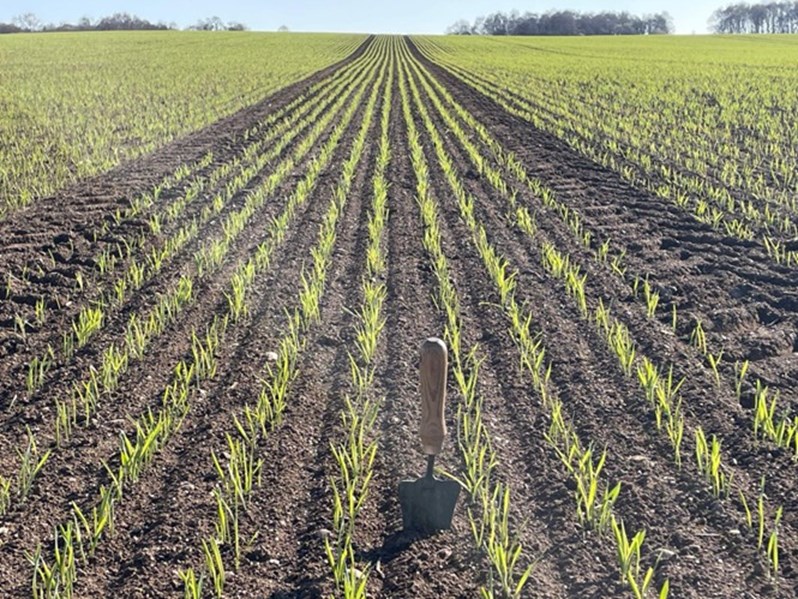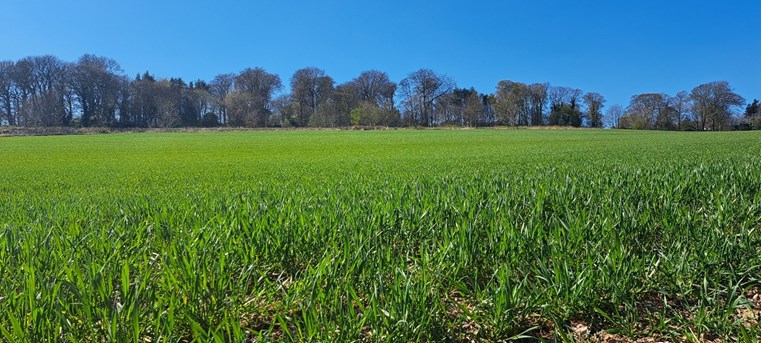Crop updates: 14 April 2025



Our regular round up of the issues affecting crops around Scotland, summarises how crops are developing and what weather and other issues are affecting them. The update provides information on the progress with key field work activities as well as news on the pest, weed and disease problems being noted in crops. The health issues being seen in crops are a key part of the topical update and lets growers and agronomists adjust management practices accordingly.
14 April 2025
General Comments
Winter cereals crops still look well in the main although a little slow to develop in dry cool conditions. Disease levels are generally low as the dry weather has helped to reduce risk; however, we have reports of mildew across several crop types, rhynchosporium starting to tick up on crops of winter barley and yellow rust is continuing to get reported across variety which on the face of it should have decent resistance. Dawsum, Bairstow and Stokes were all examples this week. There is a risk that fertiliser just sits on the surface in dry weather, but morning dews have probably helped to create just enough moisture. Crops that were starting to look hungry have greened up. Pollen beetles are coming into rape crops but will not be damaging if flowering has started. Spring barley has generally come through well with nice even emergence and growth. Where there was rain there was a risk of soils capping but even in those rare field’s growth looks to be OK.
Regional Comments
ORKNEY
We’ve had over a week of dry and often sunny weather which has seen a flurry of spring land work take place. Dung spreaders, slurry tankers, ploughs, power harrows and even grain drills have leapt into action. A further 5 days of dry weather is forecast which will hopefully result in a significant area of spring barley sown into the better-quality land. Extra appreciation must be given to farmers at this time of year when many are already working with severe sleep deprivation running their core enterprise – calving cows.
CAITHNESS
A tremendous spell of weather sees much of the spring crop in the ground in excellent conditions. There is an unprecedented, relaxed feeling knowing that time is on their side to get crop in the ground. Winter crops are also really motoring with some consistent good temperatures in the period. Some cattle now being put out to grass, approximately 10 days earlier than normal.
ABERDEENSHIRE
This has been a great spell of weather for getting spring crops sown, fertiliser spread, and early winter crop sprays applied. The usual wet weather diseases such as Rhyncosporium and Septoria have been kept at bay so far, enabling reduced rates to be applied (or no T0 sprays in some cases). Winter barley and some early sown winter wheats are at T1 now, with the first yellow flowers appearing on the winter rape. The continuing dry weather will also start to raise concerns about the effectiveness of some pre-emergence herbicides on spring crops in the near future. Cattle are also starting to be put out to grass and tattie farmers getting dreels ridged.
BANFF & BUCHAN
The current exceptional spell of weather has seen fantastic progress made with sowing and the first crops are peeping through the ground. The ground is in fine fettle, starting to warm up and latterly we are also seeing plenty of welcome sunshine. Winter oilseed rapes have jumped up with the earliest crops just coming into flower after receiving their stem extension sprays. Winter Barley crops are looking very good, plenty of tillers (at the moment) and are ready for T1 sprays and are overall fairly clean. Winter wheats have also made good progress and are just about ready for their T1s and like the barleys remain fairly clean. The first of the potato ground is starting to be made although soils are still on the cool side for planting. Grass is also now starting to come away and reports from the lambing fields are positive with plenty lambs that are getting off to a flying start.
FIFE
Fields are dry and spring seeding and potato planting is drawing to a close. Winter wheats and winter barleys are at, or approaching T1 fungicide applications, low levels of septoria can be found in wheat and the odd spot of Rhynchosporium can be found in winter barley that didn’t have a T0. Winter weed control, in most places, has been very successful. There are a few weeds emerging here and there though, so it would be a brave person to shut the gate on broad leaf weed herbicides just yet! Winter oilseed rape crops have motored away from pigeon damage to now be at early flowering, very few pollen beetles were seen, and disease levels are low. Spring barleys are emerging evenly though a few nights with light rain would benefit these and all the winter cereals.
STIRLINGSHIRE
The ground conditions across the region remain dry, although the spring cereals drilled last week are still to emerge. Spring sowing is approximately 70% complete in the region, with the western parts of Stirling still needing to finish planting. The cereal crops across the region are progressing well, with the majority showing low disease pressure. However, some winter wheat crops are exhibiting signs of Septoria, and eyespot was found in one field, winter oat crops are showing minor symptoms of powdery mildew on the odd leaf, and winter barley crops have some instances of Rhynchosporium. Overall, the crops remain relatively free of weeds, with some fields with annual meadow grass (AMG) and chickweed. While current conditions show low weed pressure, a shift in weather could trigger fresh germination. The decision not to include a herbicide in the next tank mix for the winter cereals ultimately comes down to the grower's assessment of risk. Oilseed rape has started flowering, with pollen beetles observed in large numbers, averaging 8 per plant. There is a little light leaf spot, but no significant issues at this stage. Despite the dry conditions, the crops have shown limited growth since the last update, possibly due to cooler overnight temperatures.
T1 fungicide applications will be going on the winter cereal’s shortly as some cereal crops are at GS31. Overall, the outlook for the region is positive, a different story to this time last year, with crops progressing well, though dare we say it a little more moisture is needed to fully establish the spring sowings.
LOTHIANS
A fortnight of warm sunny weather has been the tonic many backward wheats required to help warm soils and encourage nutrient uptake. These less developed wheats are still slow to progress through the growth stages compared to last year, not aided by the large swings we are seeing in daytime/nighttime temperature fluctuations. Forward wheats are at GS30. Fortunately, disease pressure is light with T0’s only required where yellow rust is or has been found. Autumn herbicides have worked well, and spring germinating weeds are being equally slow to germinate. Despite the dry seedbeds the majority of spring barley crops are now sown and germinating and emerging evenly, rains through the remainder of April would be especially welcome. No two crops of oilseed rape are the same this year and previously heavily grazed crops are now greening and growing away.
BORDERS
There has been little or no rain in the last two weeks and despite some warmer days soil temperatures remain low and winter crop growth is slow. The majority of spring crop will now be in the ground with early crops showing even emergence. Winter barley is at GS30-31, and wheat and oats are at late tillering to GS30. There is fresh mildew in oats with declining levels of foliar disease in other crops as new leaves emerge. The stable conditions have resulted in growers being ahead of normal timings for fertiliser applications and crop spraying.
LANARKSHIRE
The sun has continued to shine across Lanarkshire and isn’t set to break until next week. The good weather has continued to allow farmers to get on with spring cultivations, with lots sowing their crops in the past week or so. Therefore, most spring crops are now in the ground and some already emerging. Winter crops are still looking very well for this time of year, with many out spreading fertiliser over the weekend in the sunshine. Grass however is still limited for many, although growth is starting to pick up, making for good lambing conditions with many starting to put sucklers back outside.
AYRSHIRE
Spring is officially underway in Ayrshire with a run of consecutive bright, warm and dry days. The county is busy with field work, and much of the spring barley has been drilled. The average temperature over the past fortnight has been 9.4°C, with a high of 17.7°C and a low of 1.6°C. Daylight hours have increased to 14 hours per day. The winter barley is now into GS31 with the first node clearly detectable but the second node not yet visible. The winter barley is still very clean with minimal disease visible in the crop. The dry weather has helped to reduce the incidence risk over the past week. There is very minimal visible evidence of ramularia and net blotch but not throughout the whole crop and on less than 2% of the leaf area.
DUMFIRES AND GALLOWAY
We've been experiencing an incredible stretch of weather, which has made spring fieldwork a breeze. Most of the spring barley is now in the ground, and those that haven't been sown yet will be in the next few days. Some crops were drilled early, in mid-March, but with the cooler temperatures we've had, these crops are only just beginning to emerge. Winter crops are now approaching their T1 application stage. However, many winter barley crops in the area are looking patchy and less vigorous in places, and some rainfall is urgently needed to keep them progressing.
Posted by SAC Consulting on 15/04/2025
